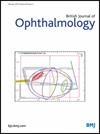Colour vision deficiency is associated with increased prevalence of amblyopia, strabismus and ametropia: a large population study
IF 3.7
2区 医学
Q1 OPHTHALMOLOGY
引用次数: 0
Abstract
Aims To examine the association between colour vision deficiency (CVD) and other ophthalmic disorders including amblyopia, strabismus and ametropia in a large population study. Methods The retrospective, cross-sectional study included 916 388 Israeli army male recruits who had their premilitary medical assessment at the age of 16–18 years from 2000 to 2020, analysing the prevalence of ophthalmic disorders including amblyopia, strabismus and ametropia in army recruits with CVD compared with all other recruits with normal colour vision. Demographic and socioeconomic data were also collected. Results The prevalence of amblyopia (1.28% vs 0.71%, p<0.001), strabismus (1.09% vs 0.83%, p<0.001) and ametropia (moderate—less than 6.00 diopters, 35.05% vs 30.50%, p<0.001 and high—higher than 6.00 diopters, 3.18% vs 2.30%, p<0.001) were all higher among 28 001 (3.06%) army recruits with CVD compared with all other individuals with normal colour vision. CVD was more common in individuals with a higher socioeconomic status (high 3.15% vs low 2.93%, p<0.001) and varied according to recruits’ origin. It was most frequent in individuals whose mother was born in the former Soviet Union (4.98%) compared with other European countries (3.89%), North America (3.28%), Asia (2.78%) and Ethiopia (1.63%). Conclusion CVD is associated with an increased frequency of amblyopia, strabismus and ametropia, which can all impart vision difficulties besides colour vision impairment alone. Data are available upon reasonable request.色觉缺陷与弱视、斜视和远视发病率增加有关:一项大型人口研究
目的 通过一项大型人口研究,探讨色觉缺陷(CVD)与弱视、斜视和远视等其他眼科疾病之间的关联。方法 该回顾性横断面研究纳入了 916 388 名以色列男性新兵,他们在 2000 年至 2020 年期间于 16-18 岁时接受了入伍前体检,与其他色觉正常的新兵相比,该研究分析了患有色觉缺陷的新兵中弱视、斜视和散光等眼科疾病的患病率。此外,还收集了人口和社会经济数据。结果 弱视(1.28% 对 0.71%,P<0.001)、斜视(1.09% 对 0.83%,P<0.001)和外斜视(中度-小于 6.00 屈光度,35.05% 对 30.50%,P<0.与所有其他色觉正常的人相比,28 001 名(3.06%)新兵中患有心血管疾病的比例更高。心血管疾病在社会经济地位较高的人中更为常见(高为 3.15%,低为 2.93%,P<0.001),并且因新兵的籍贯而异。与其他欧洲国家(3.89%)、北美(3.28%)、亚洲(2.78%)和埃塞俄比亚(1.63%)相比,母亲出生在前苏联(4.98%)的人最容易患心血管疾病。结论 CVD 与弱视、斜视和远视的发病率增加有关,除了色觉障碍外,这些疾病都会造成视力障碍。如有合理要求,可提供相关数据。
本文章由计算机程序翻译,如有差异,请以英文原文为准。
求助全文
约1分钟内获得全文
求助全文
来源期刊
CiteScore
10.30
自引率
2.40%
发文量
213
审稿时长
3-6 weeks
期刊介绍:
The British Journal of Ophthalmology (BJO) is an international peer-reviewed journal for ophthalmologists and visual science specialists. BJO publishes clinical investigations, clinical observations, and clinically relevant laboratory investigations related to ophthalmology. It also provides major reviews and also publishes manuscripts covering regional issues in a global context.

 求助内容:
求助内容: 应助结果提醒方式:
应助结果提醒方式:


